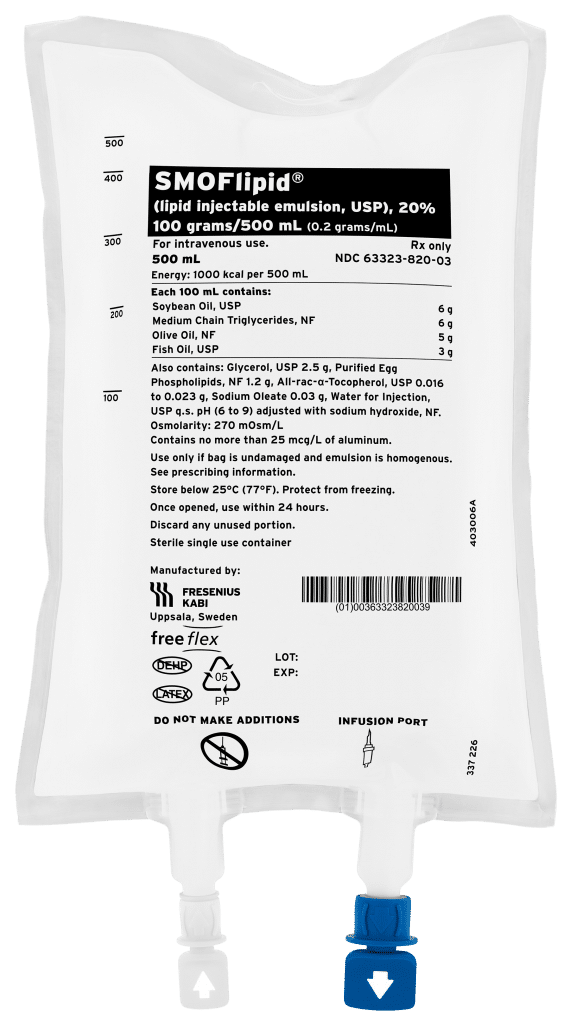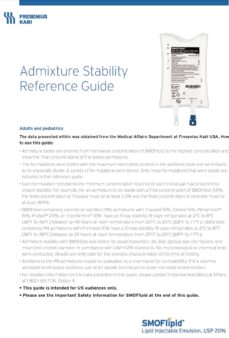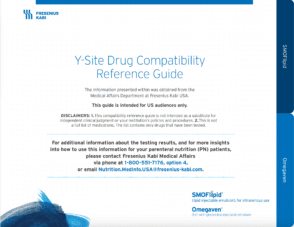

Approved for pediatric patients!
SMOFlipid is the only parenteral nutrition (PN) innovation with a unique blend of 4 oils in the US to nourish even the smallest patients.1
-

30% Soybean oil
Provides essential fatty acids. -

30% Medium-chain triglycerides (MCT)
A source of rapidly available energy.2 -

25% Olive oil
Supplies monounsaturated fatty acids. -

15% Fish oil
A good source of omega-3 fatty acids, which include EPA and DHA.3

The same product you’ve trusted for adults is approved for children 17 and under who require PN
SMOFlipid is indicated in adult and pediatric patients, including term and preterm neonates, as a source of calories and essential fatty acids for PN when oral or enteral nutrition is not possible, insufficient, or contraindicated.1
SMOFlipid helps to nurture growth in pediatric patients1,4-6
- Infants receiving SMOFlipid experienced adequate growth.*1
- Preterm infants receiving SMOFlipid experienced higher EPA and DHA levels compared to those receiving a soybean oil lipid emulsion.† 4,5
- SMOFlipid is associated with a lower omega-6 to omega-3 polyunsaturated fatty acid ratio compared to soybean oil–based lipid emulsions in preterm neonates.5,6
- SMOFlipid has a well-established safety and tolerability profile.1
*One company-sponsored trial showed equivalent total bilirubin and direct bilirubin levels comparing SMOFlipid with a soybean-based ILE.
†Based on composition of the product.
EPA and DHA (omega-3 fatty acids) are considered to be important for healthy development of infants due to their physiological roles7,8
-

May be considered conditionally essential for growth and development9,10
-

Important structural elements of cell membranes8
Appropriate dosing is vital
The dosing of SMOFlipid varies in pediatrics, neonates, and adults; each group has its own unique dosing specifications.1
| Age | Nutritional Requirements | Direct Infusion Rate | |
|---|---|---|---|
| Recommended Initial Dosage and Maximum Dosage | Initial | Maximum | |
| Birth to 2 years of age (including preterm and term neonates*) | Initial 0.5 to 1 g/kg/day not to exceed 3 g/kg/day** |
0.1 to 0.2 mL/kg/hour for the first 15 to 30 minutes; gradually increase to the required rate after 30 minutes | 0.75 mL/kg/hour |
| Pediatric patients 2 to <12 years of age | Initial 1 to 2 g/kg/day not to exceed 3 g/kg/day** |
0.2 to 0.4 mL/kg/hour for the first 15 to 30 minutes; gradually increase to the required rate after 30 minutes | 0.75 mL/kg/hour |
| Pediatric patients 12 to 17 years of age | Initial 1 g/kg/day not to exceed 2.5 g/kg/day** |
0.2 to 0.4 mL/kg/hour for the first 15 to 30 minutes; gradually increase to the required rate after 30 minutes | 0.75 mL/kg/hour |
| Adults | 1 to 2 g/kg/day not to exceed 2.5 g/kg/day** |
0.2 mL/kg/hour for the first 15 to 30 minutes; gradually increase to the required rate after 30 minutes | 0.5 mL/kg/hour |
*The neonatal period is defined as including term, post-term, and preterm newborn infants. The neonatal period for term and post-term infants is the day of birth plus 27 days. For preterm infants, the neonatal period is defined as the day of birth through the expected age of delivery plus 27 days (i.e., 44 weeks post-menstrual age).
**Daily dosage should not exceed a maximum of 60% of total energy requirements.
- Protect the admixed PN solution from light
- Use a non-vented, non-DEHP 1.2 micron in-line filter set during administration
SMOFlipid has a well-established safety and tolerability profile.1 It has been administered to more than 7 million patients worldwide.*
*Data on file 12/1/23.
KabiCare Patient Support Program for Parenteral Nutrition
Fresenius Kabi’s patient support program, KabiCare, offers online resources for claims appeals and billing as well as coding guides for parenteral nutrition.
SMOFlipid resources
Explore additional SMOFlipid materials by visiting our Resource Center.
For Consumers
SMOFLIPID® (lipid injectable emulsion USP), for intravenous use
IMPORTANT SAFETY INFORMATION
What is SMOFlipid?
- Indicated in adult and pediatric patients as a source of calories and essential fatty acids for parenteral nutrition (PN) when oral or enteral nutrition is not possible, insufficient, or contraindicated.
- The hourly infusion rate in pediatrics should not exceed 0.75 mL/kg/hour and 0.5 mL/kg/hour in adults.
SMOFlipid should not be received by patients who have:
- A known allergy to fish, egg, soybean, or peanut, or to any of the active or inactive ingredients in SMOFlipid.
- Abnormally high levels of lipid (triglycerides) in the blood.
SMOFlipid may cause serious side effects including:
- Serious Adverse Reactions with Rapid Infusion of Intravenous Lipid Emulsion in Neonates and Infants: Strictly follow the recommended total daily dosage and do not exceed the maximum infusion rate. If poor clearance of fats occurs, the infusion should be stopped, and a medical evaluation started.
- Risk of Parenteral Nutrition-Associated Liver Disease: Parenteral nutrition-associated liver disease (PNALD) may progress to liver inflammation and damage caused by a buildup of fat in the liver with scarring and cirrhosis.
- Allergic Reactions: Contact your healthcare provider immediately if you are experiencing an allergic reaction.
- Fat Overload Syndrome, Refeeding Syndrome, Elevated Triglycerides (Hypertriglyceridemia): Your healthcare provider will monitor you for signs and symptoms of early infection and blood levels.
Monitoring/Laboratory Tests: The content of vitamin K may interfere with blood clotting activity of medications.
For Consumers
SMOFLIPID® (lipid injectable emulsion USP), for intravenous use
IMPORTANT SAFETY INFORMATION
What is SMOFlipid?
- Indicated in adult and pediatric patients as a source of calories and essential fatty acids for parenteral nutrition (PN) when oral or enteral nutrition is not possible, insufficient, or contraindicated.
- The hourly infusion rate in pediatrics should not exceed 0.75 mL/kg/hour and 0.5 mL/kg/hour in adults.
SMOFlipid should not be received by patients who have:
- A known allergy to fish, egg, soybean, or peanut, or to any of the active or inactive ingredients in SMOFlipid.
- Abnormally high levels of lipid (triglycerides) in the blood.
SMOFlipid may cause serious side effects including:
- Serious Adverse Reactions with Rapid Infusion of Intravenous Lipid Emulsion in Neonates and Infants: Strictly follow the recommended total daily dosage and do not exceed the maximum infusion rate. If poor clearance of fats occurs, the infusion should be stopped, and a medical evaluation started.
- Risk of Parenteral Nutrition-Associated Liver Disease: Parenteral nutrition-associated liver disease (PNALD) may progress to liver inflammation and damage caused by a buildup of fat in the liver with scarring and cirrhosis.
- Allergic Reactions: Contact your healthcare provider immediately if you are experiencing an allergic reaction.
- Fat Overload Syndrome, Refeeding Syndrome, Elevated Triglycerides (Hypertriglyceridemia): Your healthcare provider will monitor you for signs and symptoms of early infection and blood levels.
Monitoring/Laboratory Tests: The content of vitamin K may interfere with blood clotting activity of medications.

